Table of contents
- 100 years of Suzuki Motor Corporation From looms to outboards and motorcycles
- Bestsellers SV 650, Intruder 1400 and Bandit
- Current model policy from Suzuki
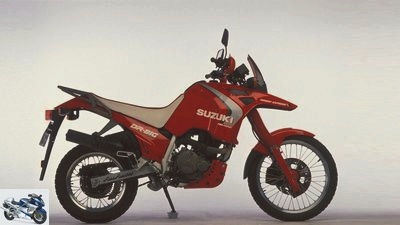
archive
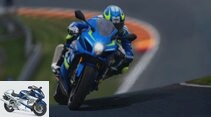

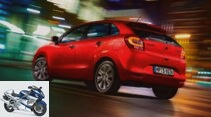
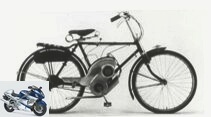
19th pictures
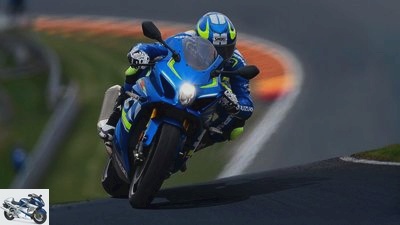
Suzuki
1/19
Suzuki doesn’t just build motorcycles. They make up less than seven percent in sales.
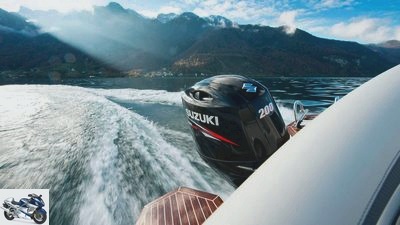
Suzuki
2/19
Suzuki can also use outboard motors.
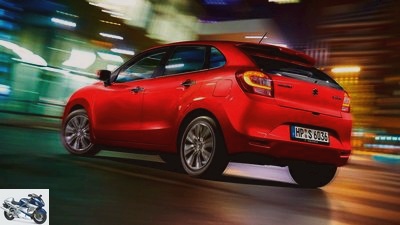
Suzuki
3/19
Over 90 percent of Suzuki sales are achieved with cars.
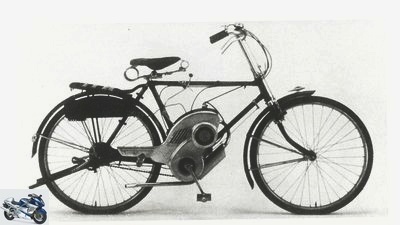
Suzuki
4/19
1952: As with Honda, Suzuki’s motorcycle beginnings consisted of an auxiliary engine that was hung in a bicycle. The Power Free had a horsepower of 36 cm³.

Suzuki
5/19
1954: The Colleda CO is the first Suzuki motorcycle with four horsepower from a 90 cc four-stroke engine. Numerous variants emerged.
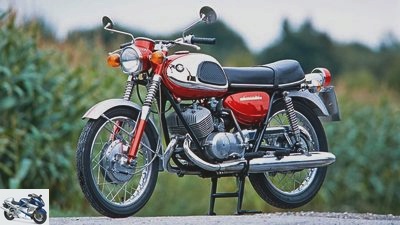
archive
6/19
1956: The T20 or Super Six is one of the first export hits for the Japanese. The 250 two-stroke engine developed a whopping 25 hp.
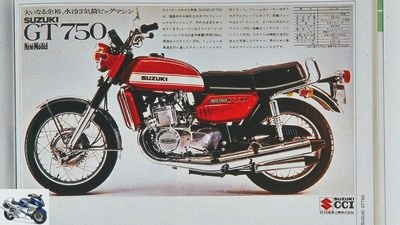
Suzuki
7/19
1971: The GT 750 called “water buffalo” was a real power tourer. The two-stroke triple made 67 very powerful horsepower.
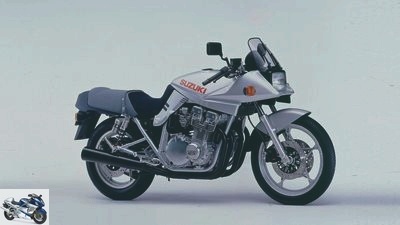
Suzuki
8/19
1981: Extroverted, strong, expensive: The GSX 1100 Katana designed in Germany was a design revolution with up to 117 hp.
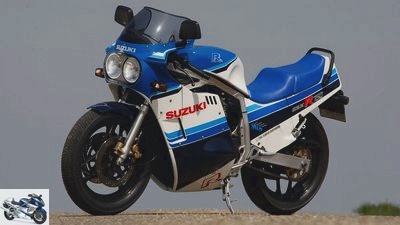
Jorg Kunstle
9/19
1984: The mother of all Gixxers: When they first appeared, there were hardly any sportier motorcycles. 100 HP at 201 kilograms swirled the sports world upside down.
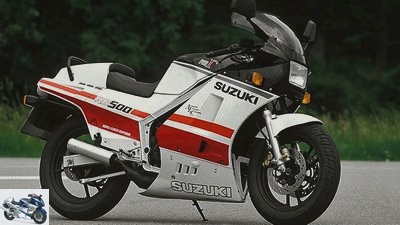
Suzuki
10/19
1985: There was no more direct transfer of GP technology to the road than with the RG 500 Gamma. Race-ready two-stroke milling machine with 95 hp, which easily became more.
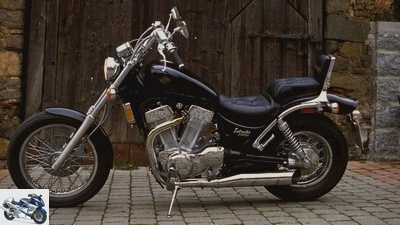
archive
11/19
1987: The first real Harley alternative: The VS 1400 Intruder was superior to the original in many ways and was mercilessly cheap.
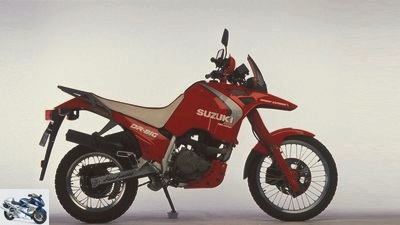
archive
12/19
1988: The DR 750 Big was the largest-capacity series single in the world. And introduced the duckbill, which is mandatory today, into the world.

Suzuki
13/19
1996: The GSF Bandit offered enormous value, whether as a speedy 600 or a powerful 1200. The Suzuki bestseller par excellence.

archive
14/19
1999: The SV 650 brought a good pinch of fire to the lethargic middle class. Went away like sliced bread for a few years.
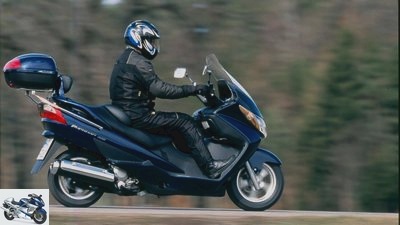
archive
15/19
1999: The Burgman 400 was the first real maxi scooter and brought the idea of performance into the scooter world.
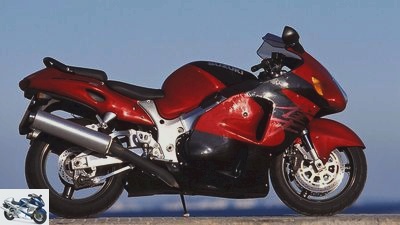
Markus Jahn
16/19
1999: The GSX-R 1300 Hayabusa was not the first, but probably the most famous speed bike. 175 HP was enough for more than 300 things at first.
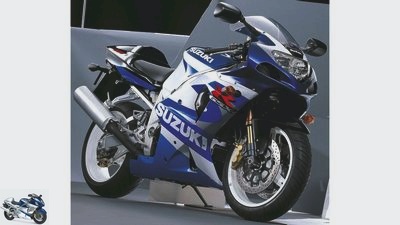
Suzuki
17/19
2001: The first GSX-R 1000 with 160 hp tore the power crown from the R1 and dominated the entire segment. Another milestone gixxer.
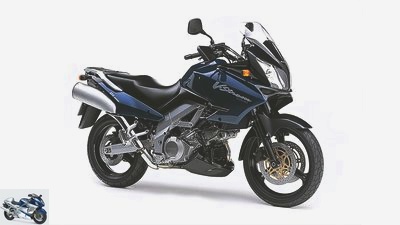
Suzuki
18/19
2002: The trend towards strong travel enduros with a lot of travel and little enduro swept the world. Suzuki contributed the DL 1000 V-Strom.
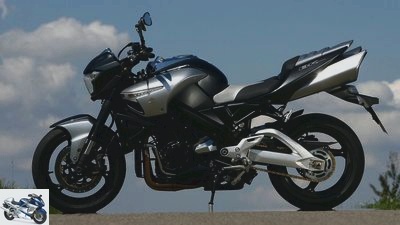
Markus Jahn
19/19
2007: A macho bike in front of the gentleman: The B-King with the Hayabusa engine was big, strong and heavy. Not a best seller, but still an absolute cult to this day.
counselor
traffic & business
100 years of Suzuki Motor Corporation
100 years of Suzuki Motor Corporation
From looms to outboards and motorcycles
Bandit, Katana, SV 650 – we look back on 100 years of Suzuki Motor Corporation, the company that started production with looms and launched its first motorcycle in 1954.
Rene Correra
March 24, 2020
In 1909, Michio Suzuki founded his company in Hamamatsu “Suzuki Loom Works”, which on March 15, 1920 in the “Suzuki Loom Manufacturing Company” is converted. However, the trained carpenter does not make motorcycles, but looms. The company flourished, went public in 1920 and became one of the largest textile machinery manufacturers in Japan. In 1936 Suzuki bought a British Austin Seven, on the basis of which several of its own prototypes were created. After the Second World War, Suzuki experimented with a small auxiliary motor, which was finally launched on the market in 1952 in combination with a bicycle as a Power Free. 1954 followed with the Colleda CO, the first motorcycle, a year later with the Suzulight the first (micro) car. In the 1960s, exports to the USA and Europe began, and with it the path to becoming an internationally successful conglomerate.
Bestsellers SV 650, Intruder 1400 and Bandit
Anyone looking for real V2 fire at a low price has landed at Suzuki for a good 20 years, mostly in the form of the SV 650. So much verve, so much Japanese quality, for so little money (price in 1999: 11,090 marks) . A lot of motorcycle for the money – a formula as simple as it is successful. Which at Suzuki was not limited to the SV 650: the first real competition for the Big Twins from Harley came at the end of the 80s with the 1400 Intruder. With a casual swing in the line, air / oil-cooled three-valve engine, 1360 cubic meters and 67 hp as well as 108 Newton meters, the “intruder” state-of-the-art technology, power and smoothness than the Milwaukee original. For a lot less money. A blessing for heavy metal fans who are out of place. And for Suzuki – a good 24,000 units were sold in Germany.
And then there is the great mother of all bestselling bikes: Queen Bandit. An aristocrat who ruled motorcycle Germany for many years. From 1996, the 1200 version in particular offered a mixture of powerful deep pressure, attractive appearance and outstanding suitability for everyday use for just under 15,000 marks. Which is why there are still almost 75,000 (!) Copies of all variants of the two-wheeled bandit (as of January 2018) in the German inventory.
Almost 20 percent market share was once upon a time
But with all the savvy – Suzuki could not only increase, but often also top value. The T20, which was already 160 things fast in 1965, the two-stroke one “Water buffalo” GT 750, the mighty Katana, the Porscheschreck Hayabusa or the often dominant GSX-R: The manufacturer from Hamamatsu participated persistently and often quite successfully in the question of who is the two-wheeled boss in the ring. Until well into the 2000s, the Japanese in Germany only knew the place in the sun. Suzuki’s piece of the German cake was at least 20 percent in size, the duel for market leadership was traditionally fought with Honda – and often won. Logical, since the Bandits, the SV 650 and the Gixxer sold like sliced bread. 24 models over 125 cubic meters competed at Suzuki in 2005 for the top of the registration statistics.
Market share today: 4.8 percent
And today? There are still 12 models. Goal: Rather relegation than top of the table. The Japanese were able to sell 5,394 units with us in 2019. In 2002, Suzuki sold almost the same amount of big bandits. Market share 2019: 4.8 percent, far behind the double-digit rest of Japan. Honda with 11.5 percent, Kawasaki with 11.3 percent and Yamaha with 10.2 percent.
How could that happen? The times are different, the fat years are over, everyone has to tighten their belts? A triplet of arguments that is certainly never entirely wrong today, but rarely sufficient. Especially since Suzuki is not doing too badly overall. Sales and operating profit have been rising steadily for several years, in the double-digit range. Worldwide sales of two-wheelers have also risen sharply since 2016, to 1.63 million units in 2019. Of course, at Suzuki, too, the large numbers and increases are mainly taking place in India and Southeast Asia. The sales relevance of the motorcycle business is negligible at less than seven percent. Aside from their lighthouse function, the traditional industrial nations markets are losing importance. This is nothing new and affects Suzuki no less than other big players. But in the case of Yamaha and Kawasaki, they still give full throttle in this country with precisely fitting and inspiring goods.
Slump in the financial crisis in 2009
Bert Poensgen was responsible for this at Suzuki for many years. The sales boss has reliably brought Suzuki to the top with early influence on model development and highly attractive pricing. His departure in 2009 as well as the financial crisis in the same year were certainly partly responsible for the fact that Suzuki’s market share has been continuously falling since then. The result is a model policy from Hamamatsu that has been tentative for years.
The worst gaps, especially in the lucrative middle class, have now been closed, but the SV 650 and GSX-S 750 are no longer as popular as they used to be. Good motorcycles, no question about it, but it’s no longer enough for the top in the segment. 200 kilograms in the 650 class, high-speed and speed-dependent Screamer four-cylinder in the upper middle class: That apparently no longer hits the nerve, the environment has evolved. It looks similar with the Power Nakeds. The K5 engine myth isn’t enough to distract you from the fact that the GSX-S 1000 is way off the top in 2019. The small V-Strom is still good for top test placements, but just like its big sister, it is now a bit conservative and unremarkable.
Current model policy from Suzuki
The current model policy of Suzuki seems to consist of reaching late, rarely and far back into the engine shelf in order to then build a solid motorcycle with little effort. That’s enough to swim along, but not to lead. That should be the long-awaited, completely renewed GSX-R 1000. Did it work? Yes and no. The new Gixxer is without a doubt the best of all time, technically up to date and finally competitive again. But the supersports market is now tiny. Anyone who wants to generate demand for the rest of the model range here has to have the strongest, fastest and best round file of all, that “Halo”-Bike. And that doesn’t currently mean GSX-R 1000.
But there is a way out: Even with a timid toe in cold water, you can be successful. You just wrap your old-fashioned engine in a snappy dress and stick the label in a clearly visible place “(Neo-) retro” on the product, see BMW R nineT. Unfortunately, the Suzuki Katana did not bring this success in 2019 – with 155 units sold, it was 160th among new registrations in the previous year.
Ideas for new models
Style and individuality are the hard currency in model politics today. So: An appealing cafe racer look put over the GSX-S 1000, an attractive price tag on it – and with little money you would have revived a real (curve) predator. Even the sports twin à la SV / TL 1000, which we and the community heavily spoiled, could be put together in a platform-compatible manner, entirely in line with the urgently needed diversification. Finally, the twin booms drilled out and complies with Euro 4 in the current V-Strom 1000. Then reinforce the SV 650 chassis, hang in the big V2 with around 125 hp, decent chassis, over it a tight garment, once half-disguised, once undisguised . Finished.
And with the purged, naturally extensive cash, new platforms and new engines could be created. So that good motorcycles become real blasters again. Hayabusa, DR, RG and so on. As is well known, there is no shortage of sonorous letters that want to be filled with new life in Hamamatsu …
Related articles
-
25 years of the Suzuki GSX-R 750
archive 14th pictures manufacturer 1/14 1998 – Injection system, steering damper, unbelievable 135 hp, reduced gear ratio, torque-increasing manifolds….
-
counselor workshop 75 years of Moto Guzzi 75 years of Moto Guzzi The emperor’s new eagle 30,000 Moto Guzzi fans witnessed the rebirth of a motorcycle…
-
50 years of Kawasaki motorcycles
archive 10 pictures archive 1/10 1991 Kawasaki Zephyr The alternative to higher-faster-further: The naked bike with air-cooled four-cylinder took up…
-
Comparison test Honda CBF 1000 F and Suzuki Bandit 1250 S
Bilski 32 pictures Bilski 1/32 The CBF 1000 F looks more elegant, dignified, sleeker. The 1250 Bandit comes across as beefier, more powerful with a more…
-
archive 22nd pictures archive 1/22 … many Kreidler RS wore expressive golf green. archive 2/22 … One of his first candidates in 1935 was a 600 BSA….
-
Second hand advice Suzuki SV 1000-S
Suzuki counselor Used purchase Second hand advice Suzuki SV 1000 / S Second hand advice Suzuki SV 1000 / S Suzuki SV 1000 / S She came, was seen ?? but…
-
100 years of MOTORRAD: Epochal bikes
MOTORCYCLE archive motorcycles 100 years of MOTORRAD: Epochal bikes 100 years of MOTORRAD: Epochal bikes signpost On the way to becoming a myth, it is…
-
20 years of triumph in Hinckley-England
archive counselor traffic & business 20 years of triumph in Hinckley / England Spotlight: History of Triumph 20 years of triumph in Hinckley / England…
-
motorcycles Top test Suzuki SV 1000 S Top test Suzuki SV 1000 S light on the horizon Anyone who knows the Japanese knows how much they take criticism to…
-
Jahn counselor Used purchase Suzuki GSX 750 used advice Second-hand advice Suzuki GSX 750 (1998 – 2003) Solid inexpensive bike When in-house model…